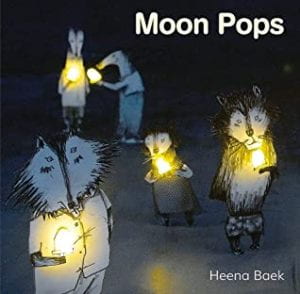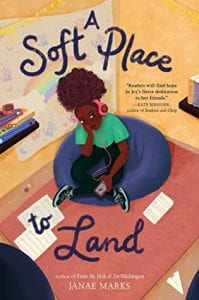 Baek, Heena. Moon Pops. Owlkids, 2021. 978-1-771-47429-0. Unpaged $19.95. Grades PreK-K.
Baek, Heena. Moon Pops. Owlkids, 2021. 978-1-771-47429-0. Unpaged $19.95. Grades PreK-K.
In Korean folklore, the full moon is associated with a rabbit pounding items with a mortar and pestle. Author and illustrator Heena Baek puts a unique spin on this folklore in her story Moon Pops (translated from the original Korean by Jieun Kiaer). One hot night, in a city populated by animals, the residents of an apartment building attempt to sleep and escape the heat. When a steady dripping noise is heard, Granny (a wolf) discovers that the moon is melting! She runs outside and catches the moon drops with her bucket. Back in her apartment, she ponders what to do with the moon drops, when the idea of making cool, refreshing moon pops (ice pops made with moon drops). When a power outage hits the building (due to too many folks running their air conditioning), Granny distributes her refreshing moon pops to her neighbors, who are refreshed and cooled by the icy treats. Later, a knock is heard at Granny’s door–it is a pair of rabbits, dejected by the loss of their now melted moon home. Thankfully, Granny has another idea up her sleeve that might just result in the restoration of the moon. The story is illustrated with photographs of mixed media 3D dioramas that give the setting and characters depth and make excellent use of the elements of light and shadow. Of special note are the moon pops themselves, which emanate a glowing light reminiscent of the moon.
THOUGHTS: This title easily could be incorporated into units on folklore, Korea, or animal stories. After reading the story, students will want to enjoy an icy treat themselves–why not go out and enjoy popsicles as a class or create your own as a class project. Highly recommended.
Picture Book Elizabeth Henry, Lampeter-Strasburg SD

